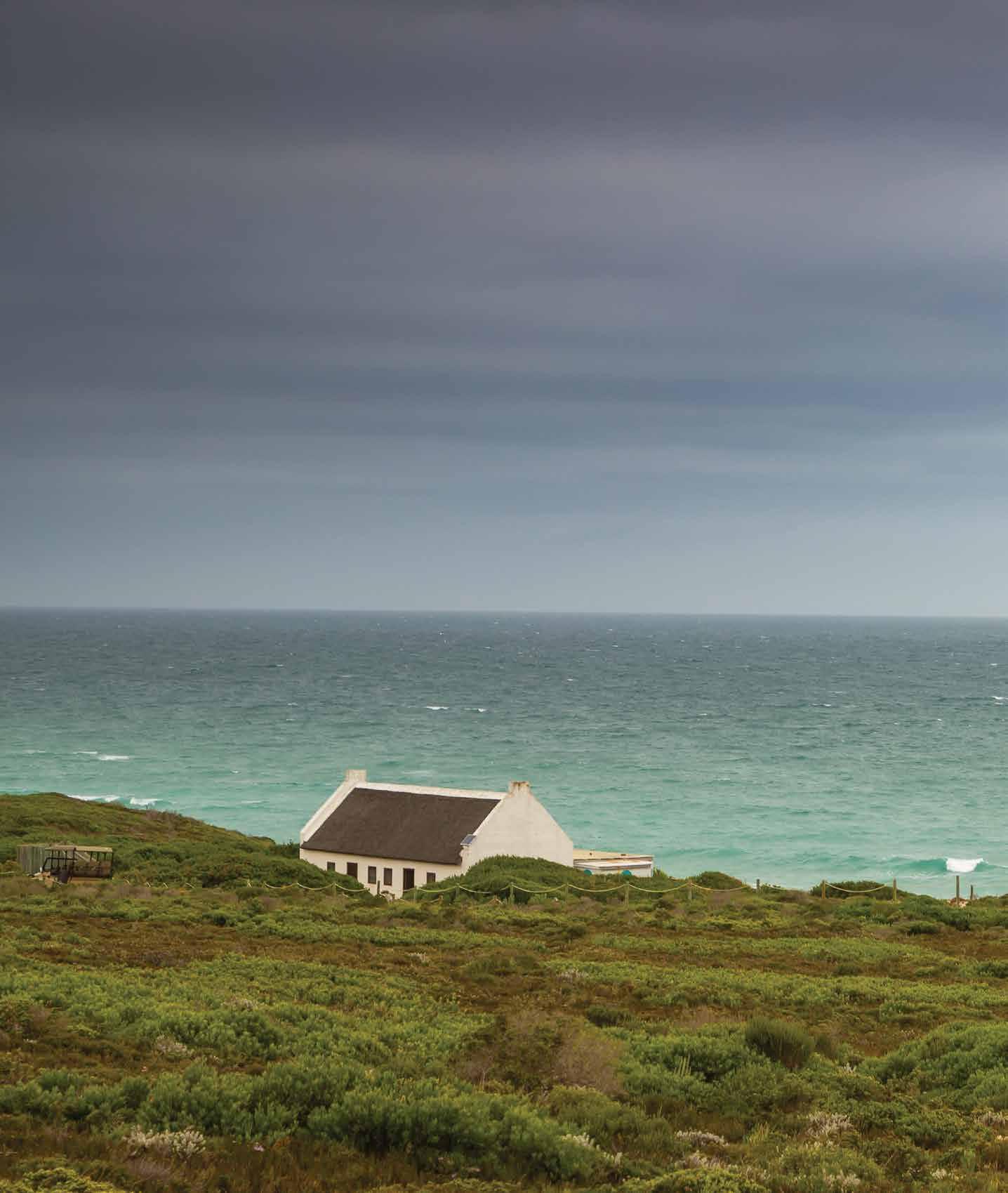
11 minute read
JOURNEY TO THE EDGE OF THE EARTH
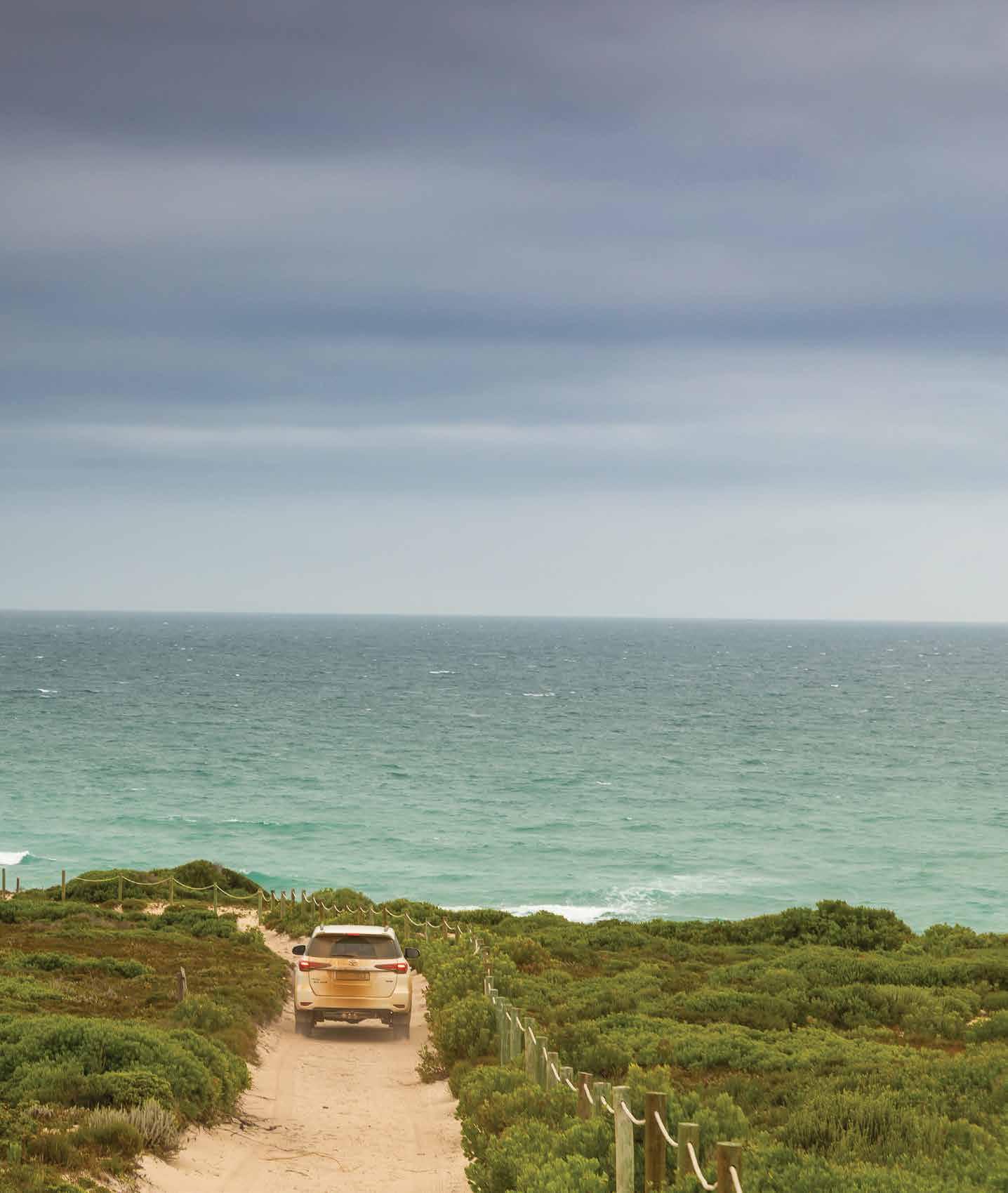
STARK BEAUTY, SHAPE-SHIFTING DUNES, DISCREET CARNAGE BELOW THE SHIMMERING SURFACE OF ROCK POOLS… KEITH BAIN ENCOUNTERS A MIX OF SAVAGERY AND SOLACE AT DE HOOP NATURE RESERVE
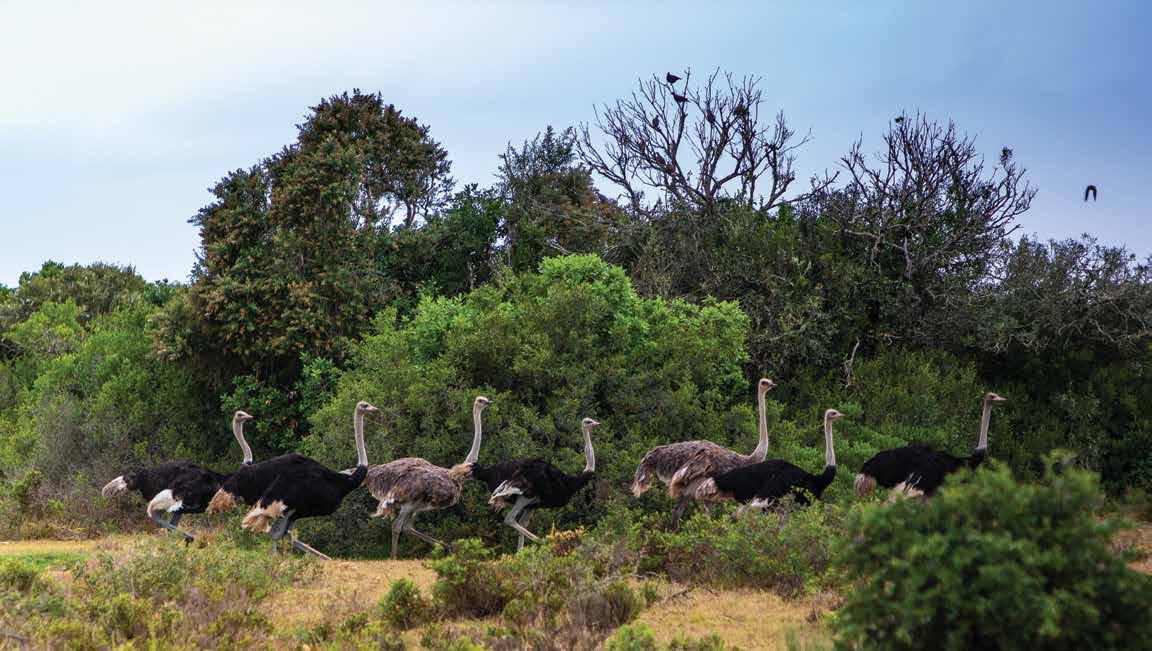
The last stretch of road was a straight stripe through sublime emptiness. It was as if we were driving to the end of the world.
Beyond Bredasdorp – our last pit stop – there was precious little. It was a 60 km stretch of bumpy gravel between vast tracts of wheat and canola fields. The odd trundling tractor was the only clue we were still on an inhabited planet, huddles of bewildered sheep the only signs of life.
If quiet was what we were searching for, we had found it before we’d even arrived. JOURNEY’S END It turns out that when you reach the end of the world, what awaits is an unblemished kingdom where a grey-green haze softens across vast plains of scraggly fynbos.
Dirt roads cut through the scrubland and over hills and disappeared towards distant pearl-white dunes. Ostriches pecked at the ground, blesbok and eland sauntered by unperturbed. An impeccable peace prevailed.
De Hoop, our destination, is a resolute and exhilarating nothingness covering some 36 000 ha, concealing within it a huge vlei, tall mountains to the east, and, on the other side of those ghostly dunes, a wild coastline unscathed by humanity.
It’s this remote, unblemished stretch of shoreline and unbounded ocean for which this pristine nature reserve is best known. For it’s here that you can witness whales from the land, in staggering numbers, perhaps better than anywhere else on the planet.
The vastness of its protected marine area where there’s not so much as a boat in sight means that the raw beaches, rich reefs and life-filled intertidal rock-zone have been perfectly preserved. Nonetheless, it’s something of an acquired taste – neither rich in predators, nor teeming with big game, its remoteness makes it ideal for seekers of isolation, solitude and respite rather than anyone looking for obvious thrills.
We were staying in one of the self-catering houses that forms part of the De Hoop Collection – centred on its Opstal, the repurposed former farmstead now a reception, shop, suites, pool and restaurant. The chef, apparently, sleeps up in one of the old grain silo towers.
Outside there are ancient figs, giant milkwoods and lawns trimmed by Cape mountain zebra and bontebok that barely batted their eyelids as we drove in.
We unloaded the contents of the car into our thatched cottage overlooking the vlei, which, depending on the time of year, teems with pelicans, and attracts up to 150 000 flamingos in summer. We had barely slunk into a lazy stupor on the stoop when the cry of a fish eagle led us off on an impromptu hike. Thing is, though, once you start walking, and exploring, you just want to go on and on and on. The raw, elemental beauty of the place is staggering.
When we did finally return to our nest, we sat on the veranda in the diminishing light of evening, absorbed the clean scent, listened to the birds, and watched as ducks sailed in perfect V-shaped formations across a sunset-washed sky. A few moments later, a straggler followed in their wake, quacking like a drunk uncle left behind at the pub.
That first night was an unfurling, a sloughing off of the city, a sinking into silence. We listened to the hoots of an owl, discerned the inky silhouettes of animals in the night, mistook a huge hare for a fox and stared up at a sky bulging with stars.

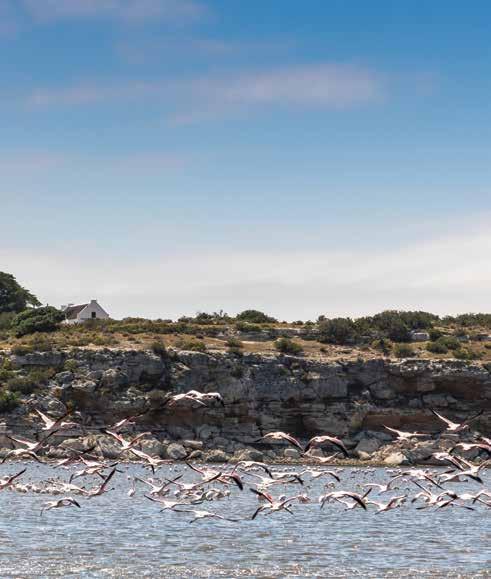
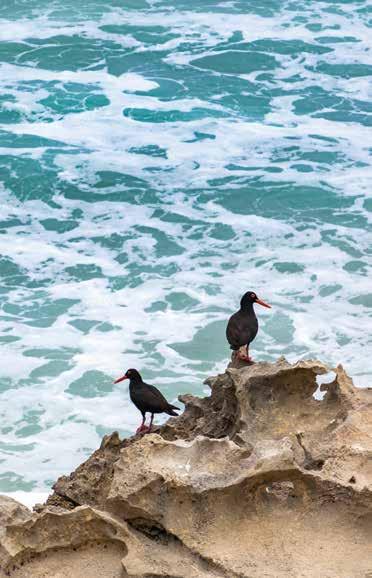

ROCK POOLS SAVAGES Morning. The ocean’s hypnotic rumbling. Sloshing waves, a lugubrious chorus.
Scuttling crabs, the distinct smell of salt and herbaceous fynbos. And like colourful explosions against the ghostly white sand and grey-green bushes, luminescent blooms in purple, pink, red and yellow.
The morning was still fresh, dew frosting the ground, the beach sand icy cold. We were with Dalfrenzo, who is, contrary to what you’d expect, not an Italian opera singer. Dalfrenzo Laing is Napier-born and bred. In fact, his name is an homage to his aunt and uncle Debby and Franz. He – with his Overberg accent punctuated by colourful Afrikaans that can’t be translated – has been guiding at De Hoop since he was still wet behind the ears, and many years later still conducts each marine walk as though he’s exploring an alien planet for the first time.
He cherishes the shoreline and its secrets like a treasured heirloom, and as we traipsed gingerly over the intertidal rocks peering into the pools, he talked about anemones, periwinkles and barnacles. In proportion to their size, the latter have the longest reproductive organ of any animal. ‘Once they’ve adhered to a surface as an adult, they never move, so they need a long one,’ Dalfrenzo explained, politely.
He showed us a sea urchin that uses it arms to grab shells, which it then uses as a shield against the sun. And he told us about limpets that are thought to practise agriculture, farming algae by urinating and defecating on them to propagate food. Limpet teeth, meanwhile, are the hardest biological material on Earth, used to scrape food off the rocks in a kind of conveyor belt action.
The rock pools were apparently full of unmitigated gore. There were gruesome killer urchins and predatory starfish that stalk the rock pools looking for fellow invertebrates to feast on. Spiny starfish turn their stomachs inside out, producing enzymes that break down their prey before ingesting them.
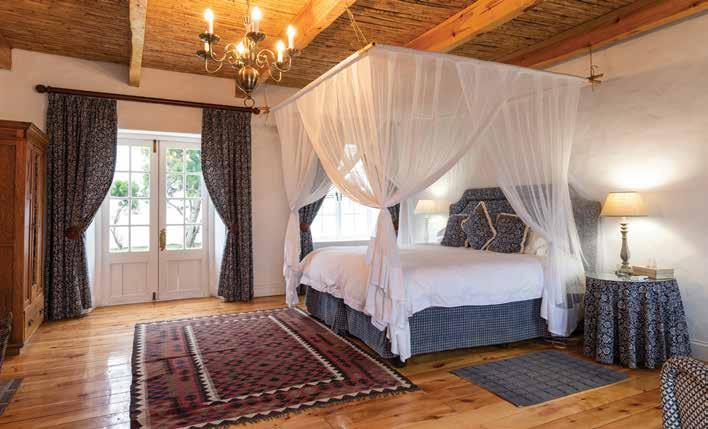
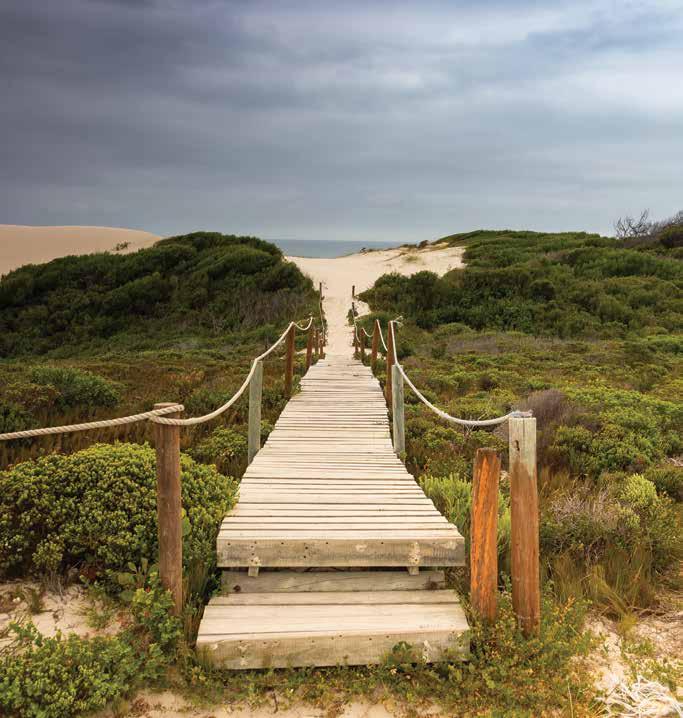
Once we had extricated ourselves from this alternative universe of curious creatures and hellish table manners, we stood on the shore for a long while, spellbound by the rolling breakers. The ocean twitched and roiled, while on the beach you could virtually hear the dunes shifting.
And then, right on cue, a whale breached and sent its tail high out of the water as if to wave at us. If all that wasn’t enough, Dalfrenzo then pointed to a pod of humpback dolphins serenely surfing the backline.
CIRCLING VULTURES In the Potberg Mountains to the east of the reserve, a unique microhabitat sustains the Western Cape’s last surviving colony of Cape vultures – or griffons. Also known as Kolbe’s vultures, they’re South Africa’s largest raptor, and truly something to behold.
‘It’s rugged where they are,’ said Calvin du Plessis, who manages one of the reserve’s lodges. ‘You have to travel a really bad and bumpy road, do an intensive hike across the river and then climb up to reach the little viewing deck. When you eventually get up there, though … whew! Wrap-around views of unimaginably wild, unspoiled fynbos wilderness.’
With this in mind, we set off in the mid-afternoon; about half an hour on a road that detours out of the reserve and back along the public road to reach De Hoop’s separate Potberg entrance. I was determined to glimpse the vultures and so set off on a trail I assumed would lead me to them. It was the most beautiful run, first through a bit of forest and then up and up and up until I was a bit unsure of where I was.
But soon, just as a wide mountain plateau sprawled out ahead of me, I became aware of being watched. Or rather, stalked. From above. Shadows moved imperceptibly around me and, gazing up, I saw three or four largewinged creatures skulking ominously on the thermals.
‘Often you’ll have vultures soaring directly above you,’ Calvin had said. ‘They’re prehistoric-looking – really grisly creatures, not at all pretty, with gruesome beaks and an oversized wingspan out of proportion to their body. And their eyes kind of penetrate the soul. They’re especially hideous when they’ve just devoured a carcass – their heads are featherless and they get full of blood.’



FIND REFUGE AT DE HOOP
De Hoop Collection A 10-minute drive from the beach, these accommodations in the vicinity of the vlei range from campsites with electric points to cottages provisioned with kitchens and braai areas, and there are suites in the ‘Opstal’, or farmstead, too. Also in the converted opstal are its restaurant and bar with indoor and outdoor seating, a pool, and shop. You can sign up for a variety of guided activities – from marine walks to vulture visits – or simply settle into the kind of silent escapism you came for, hiking or lazing on your stoop. dehoopcollection.com Morukuru Beach Lodge Facing the sea at Koppie Alleen, the top bar area of this five-bedroom beach house affords a 360° view of the surroundings including unimpeded views of the roiling ocean. The spacious, open-plan living area is designed to let the outside in so you can open all the doors and windows. It’s powered by solar panels, has hot water produced by pellet burners, and stocks snorkelling equipment, water shoes and wetsuits, sandboarding paraphernalia and mountain bikes – plus ponchos, gumboots, beach umbrellas, and a telescope for stargazing. morukuru.com Lekkerwater A class act on the far side of the reserve, this seven-room lodge occupies the site once used as a holiday home by the last president of apartheid-era South Africa. Remote and isolated, it has the atmosphere of a big seaside family farmhouse with white wooden-walled, glass-fronted box-shaped rooms arranged along a cliff to ensure gorgeous ocean views. It’s entirely off-grid, so electricity is generated by the sun, grey water is treated, there’s no singleuse plastic in sight, and most supplies are locally sourced. naturalselection.travel
The bloody faces and sinister eyes I could only imagine, but I couldn’t help but admire their masterful use of the thermals upon which their bulky bodies floated so effortlessly.
It was thrilling running with them, although I wondered how vulnerable I appeared to a hungry vulture. I’d heard from Dalfrenzo that these scavengers are known to pluck the eyes from live sheep. Now, I decided, was not the time to trip and hit my head, especially since – even more sinister still – there were also squawking crows circling, darkening the sky in a way that put me in mind of something almost medieval.
TRUE ROMANCE On our last day at De Hoop, I arose early to watch the last of the stars twinkle through the ruddy blackness as a chorus of birds got into the rhythm of a new day, like cheerleaders on the sidelines for a big game. I watched as the sky turned from bruised plum to pale blue, as a sliver of pastel light pierced the horizon.
We had been there just two days and in that compressed vacation managed to detox from the madness, the noise, the news. We didn’t tick every box on the activities list, nor did we even try. We didn’t fuss, we didn’t look for things to do, or distract us. We ate when we were hungry, dozed wherever felt comfortable. We walked, we talked, we owned the stoop, stared at the stars, we felt the squishy milk-white sea sand between our toes. We pottered, we acted out our fascination with infinitesimally small and inconspicuous life forms we’d otherwise never have known existed.
We behaved in ways people are meant to with each other – appreciatively.
I felt in those two days my atoms being rearranged, put right, like my heart was made whole again. I breathed deeper, inhaling longer and exhaling with greater satisfaction than usual. This, then, was what peace felt like.
And when we left, we were refreshed, recharged, renewed. Alive as only a trip to the end of the world could make you feel.

DINE 44
WINE 64
NIGHTLIFE 78
BEACHES 82
TABLE MOUNTAIN 84
KIRSTENBOSCH 86
GETAWAYS 87
ART 90
MUSEUMS 88
ENTERTAINMENT 89
MARKETS 92
JEWELLERY 94
SHOPPING 97
WELL-BEING 98
KIDS 100
YOUR GUIDE TO THE BEST FOOD, WINE, SHOPPING, ART AND SIGHTS ACROSS THE CAPE PENINSULA AND BEYOND
Times and prices listed are subject to change. Booking at restaurants is recommended, especially during peak season Please note that, while every e ort has been made to ensure accuracy of the details in the listings, some information might have changed due to the e ects of the global health crisis. Please call ahead to make sure.










